On March 5, all of us went to Glasgow for a field trip with the purpose of studying and observing some practical curatorial methods and discourse. Since my exhibition project is still in the process of thinking about the ideal site and exhibition layout, I focused more on observing the site characteristics and exhibition layout planning of the museum during the field trip.
HunTErian Art Gallery
As part of the University of Glasgow, Hunterian Art Gallery has a strong academic atmosphere. The exhibition hall on the first floor of the venue is a very classic way of traditional academic exhibition, which may be related to the fact that most of the exhibits are oil paintings, prints and other paintings.
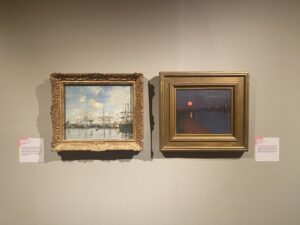
One of the galleries on the first floor of the Hunterian Art Gallery
The arrangement of these two landscapes is very interesting. The painting on the left is bright and full of the light of the day, depicting the harbor scene; The painting on the right shows the night atmosphere, with deep colors and an orange sun or moon. This contrast enhances the narrative of the exhibition and makes it easier for the audience to notice the differences in light, color and atmosphere between the two paintings. The two works complement each other, forming a visual comparison and dialogue. In my opinion, this kind of arrangement of comparing works of similar themes can lead the audience to think about different expressions of the same theme, such as how to express time and emotion through color and composition.
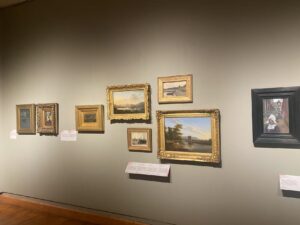
One of the galleries on the first floor of the Hunterian Art Gallery
In the exhibition hall on the first floor, this arrangement of many paintings of different sizes can also be seen everywhere. This way of display breaks the strict sense of symmetry and makes the arrangement of the exhibition more dynamic. During the tour, Kristeen asked us a question: Why are some of the frames on the walls empty and there are no paintings? Most of the students thought it was a painting being lent out or maintained, and I was no exception. But in retrospect, if this was the curator’s intention, what was it for? I think this may be a way for curators to try to increase the audience’s participation in the exhibition. The empty frame itself, as part of the artwork, allows the audience to imagine what it should show. This open way of display can encourage the audience to actively think about the connotation of the work, rather than passively accept the information.
Tramway
Tramway is a former tram garage that has since been converted into a contemporary art center. The architectural style and spatial character of the venue itself retains many of the original structural and industrial features of a streetcar garage, such as soaring metal columns, exposed ceilings and wide-span open Spaces.
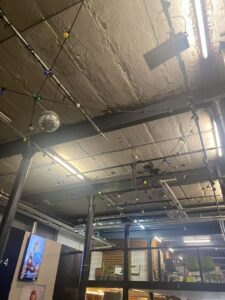
The naked deconstruction of the venue
The ceiling’s heavily exposed walls, black metal beams and pipes echo Tramway’s past as a tram garage. This unadorned design preserves the building’s original appearance to the greatest extent possible, allowing visitors to experience the venue’s past while visiting contemporary art exhibitions on Tramway. Tramway’s curatorial concept of displaying avant-garde and experimental art works in historical space is in line with the design language of preserving historical features, which can make the audience feel the sense of dialogue in time.
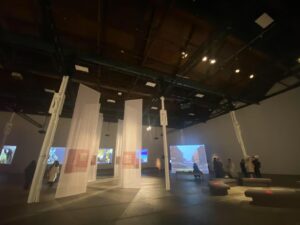
Exhibition space on the first floor of Tramway
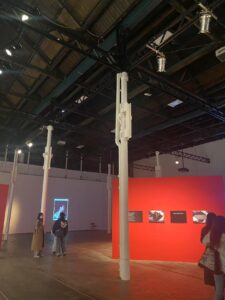
A small white box space in the exhibition
Tramway’s historic predecessor gave this exhibition space a very high height and wide open area, allowing the curators to arrange large-scale installations in this space. There is no fixed wall structure in the exhibition hall except for the four sides, so the curator can adjust the layout according to different curatorial needs. In the exhibition we visited, the curators did not use many fixed partition walls, but used the original metal columns, scattered small white box Spaces and hanging translucent screens to divide the space between the exhibits. I think this has something to do with the fact that the exhibition is mostly video art and immersive installations. The multiple layers of walls and cloth add a sense of atmosphere to the display of video works. When the audience moves freely through the space, their shadows may also appear on the curtain or the wall, which also adds to the interactive nature of the exhibition.
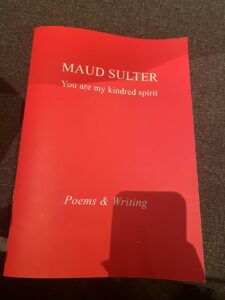
A collection of texts from the exhibition
As part of an immersive audiovisual installation, Maud Sulter loops recordings of herself reading her poems throughout the exhibition and organizes the texts into volumes for the audience to read. The extensive exhibition space on Tramway’s ground floor makes the sound installation a more immersive experience for visitors.
Gallery of Modern Art(GoMA)
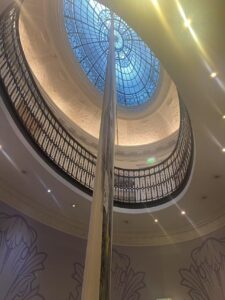
Banners hanging from the ceiling in the museum
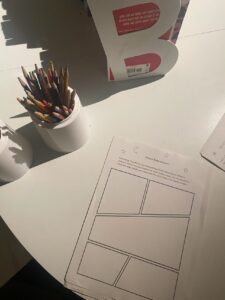
An interactive area in the exhibition
As the building is a former merchant residence, the interior structure of GoMA does not have a very large exhibition hall like Tramway, but a very clear zoning for the exhibition. GoMA’s moving line planning is more clear, and most of the visitors are guided by circular or linear paths to get a complete viewing experience. In addition, due to the limited indoor lighting, GoMA’s lighting arrangement is very flexible. For example, in an audio work on the fourth floor of the exhibition hall, GoMA uses lights to frame the area where the sound can be heard on both sides. GoMA’s exhibition has a lot of interactive areas, basically using a piece of art as a sample, allowing the audience to imitate the content of the creation. There is also a desk in the center of the exhibition hall on the fourth floor, where visitors can read some books related to the exhibition.
Summary
After visiting three galleries of different styles in Glasgow, I understand the influence of different exhibition Spaces on the presentation of art works, as well as the considerations of curators in the layout of exhibition Spaces, the use of lighting and the audience experience. After comparing the exhibition strategies of the three galleries, I came up with several questions about the exhibition. The first is how does the exhibition space affect the way the audience sees it? The traditional academic exhibition hall of Hunter Gallery can present works intuitively, but it may limit the active exploration of the audience. The open space of Tramway gives the audience a flexible way of viewing the exhibition, but it is slightly weak in the aspect of structured narrative. GoMA encourages the viewer to follow the logic of a linear narrative, but some installations may be restrained by the constraints of the site. The form of the exhibition space should not become the constraint of the content, but should guide the audience to find a balance between immersion and logic through flexible curation to obtain the best viewing experience. Secondly, how does the lighting arrangement affect the shaping of the exhibition atmosphere? The light of Hunter Gallery is uniform and direct, which can show the details of the works to the greatest extent, but it is slightly boring. The exhibition hall of Tramway uses a local light source to create a dim environment, which enhances the immersive feeling of the exhibition, but may cause inconvenience for the audience to read the text and some details of the works. GoMA’s lighting system is flexible and able to balance the needs of different exhibition contents. Exhibition lighting is not only an auxiliary tool, but also a part of the narrative means of the exhibition. When designing lighting, curators should carefully analyze the characteristics of works, rather than simply apply standardized programs. Thirdly, how to balance the academic and interactive nature of the exhibition? The Hunter Gallery is undoubtedly the most academic of the three, but hardly interactive; Tramway’s exhibitions are interactive but lack the academic framework in the traditional sense. GoMA tries to balance the two, but still prefers static viewing in the exhibition. The exhibition should not be just a static display board of works, but a field where academic knowledge and interactive experience of the audience can be blended. Finally, whether it is a traditional academic art museum or an experimental art space transformed by abandoned factories, stations and other buildings, it is necessary to consider how to make the audience participate in the exhibition more actively, break the single static viewing, and make the exhibition truly become a communication bridge between the audience and the work, the author and the space.



